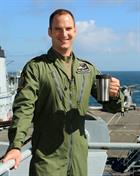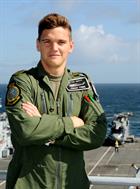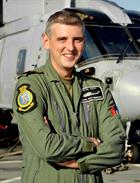Aviators Find Their Sea Legs
Trainee aviators have been trying to find their sea legs during a six week training exercise to see if they have got what it takes to fly at sea.
As the majority of students across the country have just begun a new academic term, the trainee aircrew from 824 Naval Air Squadron are about to be awarded with their Wings – but only if they pass the final, and most difficult part of their course; the sea phase. This has been the first time that the students have practiced their flying skills at sea, having performed most of their training so far in the state of the art flight simulators at Royal Naval Air Station Culdrose.
824 Naval Air Squadron plays a vital role in training the Royal Navy’s future Pilots, Observers and Aircrewmen who will eventually serve onBritain's newest aircraft carrier, the HMS Queen Elizabeth. The squadron trains aircrew and engineers in every aspect of the Merlin helicopter, equipping them with the knowledge and skills that will be required once they deploy on Naval operations. Before the students take to the air, the students are taught in ‘ground school’ and undergo computer based training in specially designed helicopter simulators, enabling them to practice flying procedures in a safe controlled environment.
The ‘sea phase’ is the final part of the training course, but is the most testing as the Training Officer from 824 Naval Air Squadron, Lieutenant Commander Steve Hayton explained: “The sea phase is where the students really show what they can do, it is a vital part of the course. They must work together and put all that they have learnt into practice but in the unforgiving environment of the sea. It is their final embarked training exercise before they are due to get their Wings in October – if they don’t pass this stage, they don’t get their Wings.”
The current cohort of Merlin students are the first full compliment to go through training for the Merlin Mk2 helicopter - the most advanced maritime helicopter in the world.
During their deployment at sea, they have been based onboard RFA Argus. The course of six student aircrew has been flying three Merlin helicopters to and from the ship in the Southwest approaches. They have been practicing deck landings, tactical sorties and generally preparing for aviation at sea. After they honed their flying skills, they moved onto more advanced sorties including searching for submarines.
One of the students, Lieutenant Chris Ford said: “We have been developing our flying skills and carrying out deck landings, helicopter controlled approaches, emergency approaches in low visibility and carrying out refuelling whilst in flight – all essential skills for aviation at sea. We have also been hunting submarines too.”
Fellow student Lieutenant Dominic Rotherham said: “We were really put through our paces, but we all work together as a team. If one of us makes a mistake – we could all end up in the water, but in the simulator, well you can just get out!”
“It has been a long journey to get to where we are now. Everything that we have had to do over our past training leads to here. I have flown to a simulated deck of RFA Argus quite a few times in the simulator, but now I have done it for real, and boy is it different! There is a lot of repetition, but we need to nail the key skill of deck landings in particular, because every sortie starts with a take off from a ship and every sortie ends with a landing.”
After his first deck landing, Lieutenant Mac Nicoll said: “The first deck landing was quite emotional. I knew what I was doing because I have practiced it many times in the simulator, but it is a lot more real when you have got the sea around you. Psychologically it is very different. Putting the helicopter down successfully on the back of a moving ship is the real deal.”
LA Arron Tobin, who is training to be an Aircrewman said: “We have spent a lot of time with our heads in books and in the simulator, so it has been really rewarding to put all that theory into practice. The past few weeks have been essential and have enabled us to prove that we are capable of doing the job and ready for the frontline. I have already served at sea as a Merlin helicopter engineer, but this experience has been very different, especially now that the Merlin has had an upgrade. Wings is not very far away and all the crew have become very close knit - it is a real team effort and we all want to make it.”
The other Aircrewman in training, LH Liam Armstrong added “It is not just about aviation, we have got to get used to life onboard a ship. I have learnt lots about the routines onboard a ship, but other important things too like securing your wets (cup of tea) when the ship is moving about! This was my first time at sea and my stomach didn’t like it too much at the beginning. I wasn’t as bad as some of the trainee engineers though!”
Not only do the ‘sea phase’ deployments put the students though their paces, they also provide important aviation training for everyone on the ship, ensuring that all personnel are well rehearsed in safe aviation at sea.








